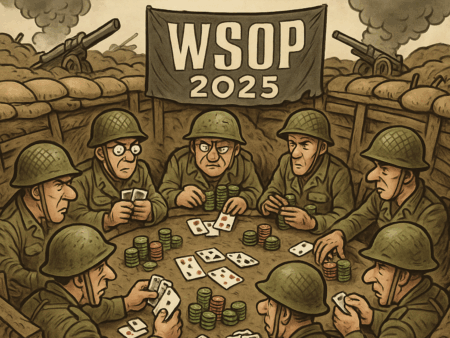
Poker strategy often focuses on absolute factors: how strong a hand is, how many chips a player has, or how much equity a shove carries. Yet in tournaments, particularly near the bubble, these absolutes are misleading. The real key lies in stack geometry – the relational balance of chip stacks around the table and the unique pressures those relationships create. For beginners, stack geometry is often taught in simple terms: big stacks bully, medium stacks tighten, short stacks shove. But this framework, while useful, barely scratches the surface.
At higher levels of play, stack geometry is not static but dynamic and multi-dimensional, acting more like a web of shifting vectors than a fixed set of categories. By taking the concept further, we can uncover deeper truths about how tournament poker actually functions and why medium stacks, in particular, must navigate the most complex terrain.
- Read more: The Hidden Flaw in Equity Calculators: Why cEV ≠ $EV
- Read more: Eldarova’s Dynamic Exploit Equilibrium (DEE) Theory
From Static Categories to Pressure Vectors
Traditional thinking reduces players to big, medium, or short stacks, but this oversimplification hides the reality that each stack projects a unique form of leverage. A more accurate model sees each stack as a vector of pressure: a directional force that influences opponents differently depending on who they cover, who covers them, and where they are seated.
Big stacks exert long, thick vectors of dominance – they can credibly threaten elimination, push marginal spots, and reshape others’ ranges. Medium stacks project narrower, conditional vectors: they can pressure shorter stacks but lose power when covered by larger stacks. Short stacks, meanwhile, generate short but sharp vectors – although their fold equity is low, their all-ins impose tough ICM calculations on those considering a call. This vision transforms a poker table from a static arrangement of chips into a battlefield of overlapping influences.

Beyond Three Categories: Layers of Stack Function
Once we think in terms of vectors, the simple three-part taxonomy collapses. Instead of only “big, medium, short,” we can define functional stack layers that behave differently under pressure.
A mega-stack, vastly larger than the field, warps the entire table like a queen on the chessboard, pressuring every decision.
A healthy medium stack of twenty-five to thirty blinds can still play a full range but faces the danger of elimination if covered. A fragile medium stack of fifteen to twenty blinds has far less room for manoeuvre: too large to treat as a short stack, too small to exert much fold equity.
Below that, a critical short stack of six to twelve blinds can shove profitably but has little scope for post flop play, while a micro-stack of fewer than five blinds functions almost like an “ICM shield.” Their very presence forces medium stacks to fold hands they would otherwise play, hoping the micro-stack busts first. These distinctions matter, because each layer projects its own kind of vector pressure, and knowing which layer you occupy is essential to interpreting your role.
The Positional Dimension: Geometry Is Not Proportional
Stack geometry also cannot be reduced to chip counts alone. A medium stack with twenty-five blinds in the cutoff behind two short stacks plays entirely differently from the same stack in early position with a mega-stack lurking on the button.
Geometry is positional as well as proportional. Seat order determines who applies pressure and who absorbs it. When a medium stack is behind shorts, they can widen their range and attack freely. When they are covered by big stacks, especially those on the left, their aggression shrinks dramatically. When sandwiched between both larger and smaller stacks, their options are most constrained. Thus, the same stack size can have wildly different shapes depending on who is seated nearby. Thinking geometrically means recognising that a stack’s leverage changes every orbit, not only when chips are won or lost.

The Geometry of Risk Transfer
Perhaps the most powerful insight of next-level stack geometry is that it defines not only pressure but also who pays the risk premium in any confrontation.
When a big stack raises into medium stacks, it is the medium stacks who pay the premium, because they risk elimination while the big stack does not. When a medium stack raises into short stacks, the premium flips: the short stacks are forced to gamble for their tournament lives while the medium stack risks only a portion of theirs. In medium-versus-medium collisions, the risk is shared more evenly, but position then acts as a leverage multiplier, giving the in-position player disproportionate control. Thinking in terms of risk transfer reframes decisions: every bet is not just a play for chips but a reassignment of tournament equity risk from one stack to another.
Dynamic Shifts and the Timing of Aggression
Another crucial truth is that stack geometry is fluid. It shifts orbit by orbit as blinds increase, stacks dwindle, and short stacks double. A healthy medium stack of twenty-five blinds can quickly become a fragile medium after one orbit of inactivity, while a short stack that doubles instantly alters the geometry of the table. Elite players exploit these transitions by timing their aggression to coincide with moments when their opponents’ geometry is at its weakest – such as when a medium stack has just slipped below twenty blinds or when a micro-stack is poised to bust. Recognising not only where the geometry stands now but also how it is likely to shift in the next few hands separates strong bubble players from truly elite ones.
Toward a Geometric Map of the Bubble
When we combine vectors, layers, positions, and risk transfers, we arrive at a vision of the bubble as a geometric heat map of aggression potential.
Big stacks create red zones of maximum leverage, where fold equity is highest. Medium stacks under coverage produce blue zones of constraint, where survival instincts dominate. Short stacks in blinds add green zones of shove potential, creating spikes of forced action. The table ceases to be just nine seats with chip counts and becomes a positional battlefield where the geometry of stacks dictates who can act, who must wait, and where risk is distributed. In this sense, bubble play is less about cards and more about navigating shifting vectors of pressure, like manoeuvring through a storm of invisible currents.
Next-level stack geometry reframes tournament poker as a study not of chips but of relationships. It teaches us to see each stack not as a number but as a vector of pressure and risk, to distinguish functional layers rather than lump stacks into blunt categories, and to recognise how seat order transforms proportional strength into positional advantage.
It emphasises that risk is transferable and that timing aggression around dynamic shifts is often more profitable than any single hand decision. For medium stacks, in particular, this framework clarifies why their role is the most difficult and the most nuanced: they project limited power while absorbing maximum risk. By adopting this geometric lens, players can transform confusion into clarity and turn the bubble from a minefield into an opportunity to exploit others who have yet to grasp its true shape.
























